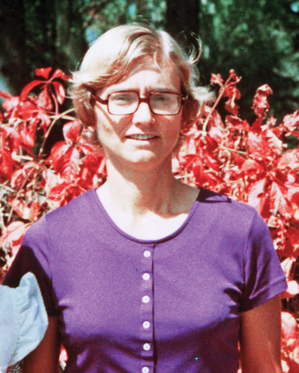A Binder Full of Physicists
A prominent male physicist once told Vera Kistiakowsky, who arrived at MIT in 1963 as a researcher in the Laboratory for Nuclear Science, “It is too bad that you were not born a man.” Later, she was “cornered by an indignant lady, the wife of a Nobel laureate physicist,” Kistiakowsky says. “She did not think that women should be doing physics.” Instead, women should be taking care of everything else so that men—like her husband—could do physics.

Maybe the worst moment came in February 1971, during the American Physical Society’s first session on women in physics, in New York. Kistiakowsky watched audience members make wisecracks and inappropriate comments during the proceedings. “It made me want to get up and scream,” she says. Instead, she formed the Committee on Women in Physics under the auspices of the American Physical Society “so I could rub the facts in.” Male physicists at the time said the reason there were no female physics professors was that there were no female physicists to hire, and Kistiakowsky wanted to prove them wrong.
Fifteen other women from around the country joined the committee, and Kistiakowsky got a $10,000 grant from the Sloan Foundation to fund a questionnaire. “The American Physical Society nearly keeled over in a dead faint, because I was the first committee that had ever come in with money of its own,” she said in a 1976 interview as part of the MIT Oral History Program.
The committee compiled a roster of female physicists to counter claims that there were no qualified ones to hire. It also sent questionnaires to all the women in physics it could find, asking about their employment, their employer’s child care and maternity leave policies, whether they’d encountered any discriminatory rules, and if they were satisfied with their job.
By the fall of 1971 the committee had received hundreds of responses. “Dear Sisters!” one woman wrote across her questionnaire. “I appreciate what you are doing. For the first time ever, I feel less alone as a female physicist!”
Women sent in their horror stories and those of their friends, qualified people who had remained unemployed for years. Kistiakowsky received many long letters, two postcards, and even a flimsy blue airmail envelope from two master’s students in India who wanted to join the committee.
Many women wanted more influence and the possibility of being promoted. One administrative assistant with a bachelor’s degree in physics wrote that she wanted “less shitwork + more responsibility.” Another wrote: “It is an unwritten rule … but I will never advance to a management position.”
Salary was a nearly ubiquitous concern. An associate physicist wrote, “A man with the exact degree as mine started with a salary of $11,400 compared to my $8,200. By exact, I mean the degrees were from the same university, same department, under the same professor.”
Another woman wrote that the men in her department felt that “women don’t need to be paid as much as men for the same job since they spend their money on frivolities.”
An optical physicist wrote, “I resent being used by NASA as a symbol of their equal employment to women when in fact I feel women are discriminated against in many subtle ways.”
The committee’s final report was two and a half inches thick. Kistiakowsky printed out copies and hauled them to the APS council. “I went into the spring meeting in ’72 and banged down that box on the table,” she says. “Everybody’s eyes opened wide.”
The report did what Kistiakowsky wanted it to do: “When we requested a permanent committee on women in physics, there was no argument,” she says. The APS created the Committee on the Status of Women in Physics in 1972, and it’s remained in existence ever since. Kistiakowsky got back to focusing on her experimental research on hadron interactions. In 1972 she became the first woman to be appointed a full professor in the MIT physics department.
From 1920 to 1971, the percentage of physics doctorates awarded to women decreased from 4 percent to 3 percent. By 2012, it had climbed to 20 percent. The Committee on the Status of Women in Physics continues to try to nudge that number higher.
Kistiakowsky is pleased with what the committee has accomplished. The difference it’s made has been simple: “It meant that a professor that might have turned down a woman graduate student would take her,” she says.
Keep Reading
Most Popular
Large language models can do jaw-dropping things. But nobody knows exactly why.
And that's a problem. Figuring it out is one of the biggest scientific puzzles of our time and a crucial step towards controlling more powerful future models.
How scientists traced a mysterious covid case back to six toilets
When wastewater surveillance turns into a hunt for a single infected individual, the ethics get tricky.
The problem with plug-in hybrids? Their drivers.
Plug-in hybrids are often sold as a transition to EVs, but new data from Europe shows we’re still underestimating the emissions they produce.
Stay connected
Get the latest updates from
MIT Technology Review
Discover special offers, top stories, upcoming events, and more.